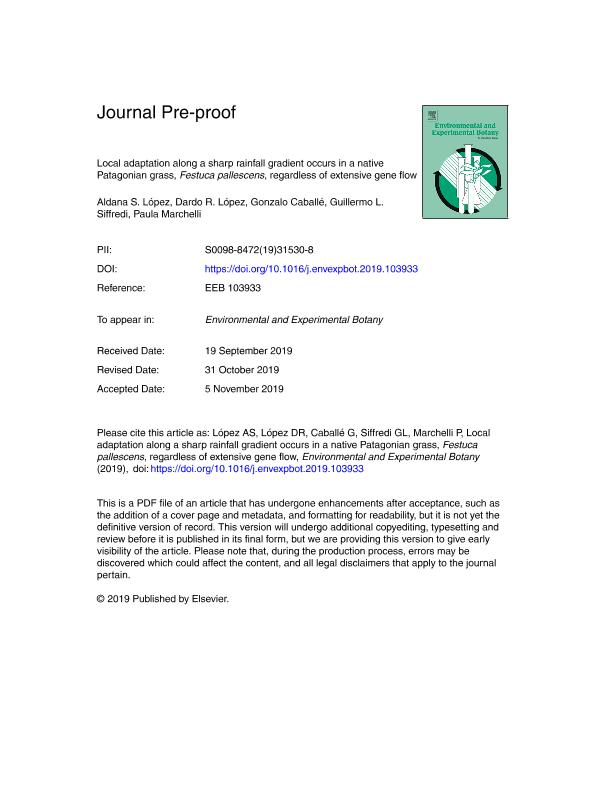Mostrar el registro sencillo del ítem
dc.contributor.author
López, Aldana Soledad

dc.contributor.author
López, Dardo Rubén

dc.contributor.author
Caballe, Gonzalo

dc.contributor.author
Siffredi, Guillermo Lorenzo

dc.contributor.author
Marchelli, Paula

dc.date.available
2023-08-23T14:03:59Z
dc.date.issued
2020-03
dc.identifier.citation
López, Aldana Soledad; López, Dardo Rubén; Caballe, Gonzalo; Siffredi, Guillermo Lorenzo; Marchelli, Paula; Local adaptation along a sharp rainfall gradient occurs in a native Patagonian grass, Festuca pallescens, regardless of extensive gene flow; Pergamon-Elsevier Science Ltd; Environmental and Experimental Botany; 171; 103933; 3-2020; 1-11
dc.identifier.issn
0098-8472
dc.identifier.uri
http://hdl.handle.net/11336/209059
dc.description.abstract
Increasing global aridity combined with changing environmental conditions might cause irreparable alterations in arid and semiarid ecosystems. Knowledge of within-species genetic diversity and adaptive responses, especially along climatic gradients, becomes critical to inform management, conservation and restoration efforts. We combine the analysis of neutral (microsatellites) and adaptive divergence (morphological traits in common garden experiments) between populations along a sharp precipitation gradient in the native Patagonian grass Festuca pallescens, to disentangle patterns of local adaptation and genetic diversity. The identification of genetically based traits under divergent selection denoted the existence of local adaptation in spite of extensive gene flow. Two plant growth patterns were detected associated with two ecological regions. In arid environments, a trade-off between not resigning foliage production, and reducing the exposure to drying agents resulted in a compacted plant architecture; while in dry subhumid environments, populations exhibited a wide architecture to cope with rainfall and radiation interception. Increasing aridity and grazing might favor a compact plant architecture, and fragmentation might reduce genetic diversity across these environments. Being a widely distributed species, F. pallescens is an excellent model species to study adaptive responses across environmental gradients facing climate change predictions, especially in dryland rangelands that maintain multiple ecosystem functions.
dc.format
application/pdf
dc.language.iso
eng
dc.publisher
Pergamon-Elsevier Science Ltd

dc.rights
info:eu-repo/semantics/openAccess
dc.rights.uri
https://creativecommons.org/licenses/by-nc-nd/2.5/ar/
dc.subject
DRYLANDS
dc.subject
ENVIRONMENTAL GRADIENTS
dc.subject
FESTUCA PALLESCENS
dc.subject
LOCAL ADAPTATION
dc.subject
NEUTRAL GENETIC DIVERSITY
dc.subject
PHENOTYPIC VARIATION
dc.subject.classification
Agronomía, reproducción y protección de plantas

dc.subject.classification
Agricultura, Silvicultura y Pesca

dc.subject.classification
CIENCIAS AGRÍCOLAS

dc.title
Local adaptation along a sharp rainfall gradient occurs in a native Patagonian grass, Festuca pallescens, regardless of extensive gene flow
dc.type
info:eu-repo/semantics/article
dc.type
info:ar-repo/semantics/artículo
dc.type
info:eu-repo/semantics/publishedVersion
dc.date.updated
2023-08-15T23:07:16Z
dc.journal.volume
171
dc.journal.number
103933
dc.journal.pagination
1-11
dc.journal.pais
Países Bajos

dc.journal.ciudad
Amsterdam
dc.description.fil
Fil: López, Aldana Soledad. Instituto Nacional de Tecnología Agropecuaria. Centro Regional Patagonia Norte. Estación Experimental Agropecuaria San Carlos de Bariloche. Instituto de Investigaciones Forestales y Agropecuarias Bariloche. - Consejo Nacional de Investigaciones Científicas y Técnicas. Centro Científico Tecnológico Conicet - Patagonia Norte. Instituto de Investigaciones Forestales y Agropecuarias Bariloche; Argentina
dc.description.fil
Fil: López, Dardo Rubén. Instituto Nacional de Tecnología Agropecuaria. Centro Regional Córdoba. Estación Experimental Agropecuaria Manfredi. Estación Forestal Villa Dolores; Argentina
dc.description.fil
Fil: Caballe, Gonzalo. Instituto Nacional de Tecnología Agropecuaria. Centro Regional Patagonia Norte. Estación Experimental Agropecuaria San Carlos de Bariloche. Instituto de Investigaciones Forestales y Agropecuarias Bariloche. - Consejo Nacional de Investigaciones Científicas y Técnicas. Centro Científico Tecnológico Conicet - Patagonia Norte. Instituto de Investigaciones Forestales y Agropecuarias Bariloche; Argentina
dc.description.fil
Fil: Siffredi, Guillermo Lorenzo. Instituto Nacional de Tecnología Agropecuaria. Centro Regional Patagonia Norte. Estación Experimental Agropecuaria San Carlos de Bariloche. Instituto de Investigaciones Forestales y Agropecuarias Bariloche. - Consejo Nacional de Investigaciones Científicas y Técnicas. Centro Científico Tecnológico Conicet - Patagonia Norte. Instituto de Investigaciones Forestales y Agropecuarias Bariloche; Argentina
dc.description.fil
Fil: Marchelli, Paula. Instituto Nacional de Tecnología Agropecuaria. Centro Regional Patagonia Norte. Estación Experimental Agropecuaria San Carlos de Bariloche. Instituto de Investigaciones Forestales y Agropecuarias Bariloche. - Consejo Nacional de Investigaciones Científicas y Técnicas. Centro Científico Tecnológico Conicet - Patagonia Norte. Instituto de Investigaciones Forestales y Agropecuarias Bariloche; Argentina
dc.journal.title
Environmental and Experimental Botany

dc.relation.alternativeid
info:eu-repo/semantics/altIdentifier/url/https://www.sciencedirect.com/science/article/pii/S0098847219315308
dc.relation.alternativeid
info:eu-repo/semantics/altIdentifier/doi/https://doi.org/10.1016/j.envexpbot.2019.103933
Archivos asociados
